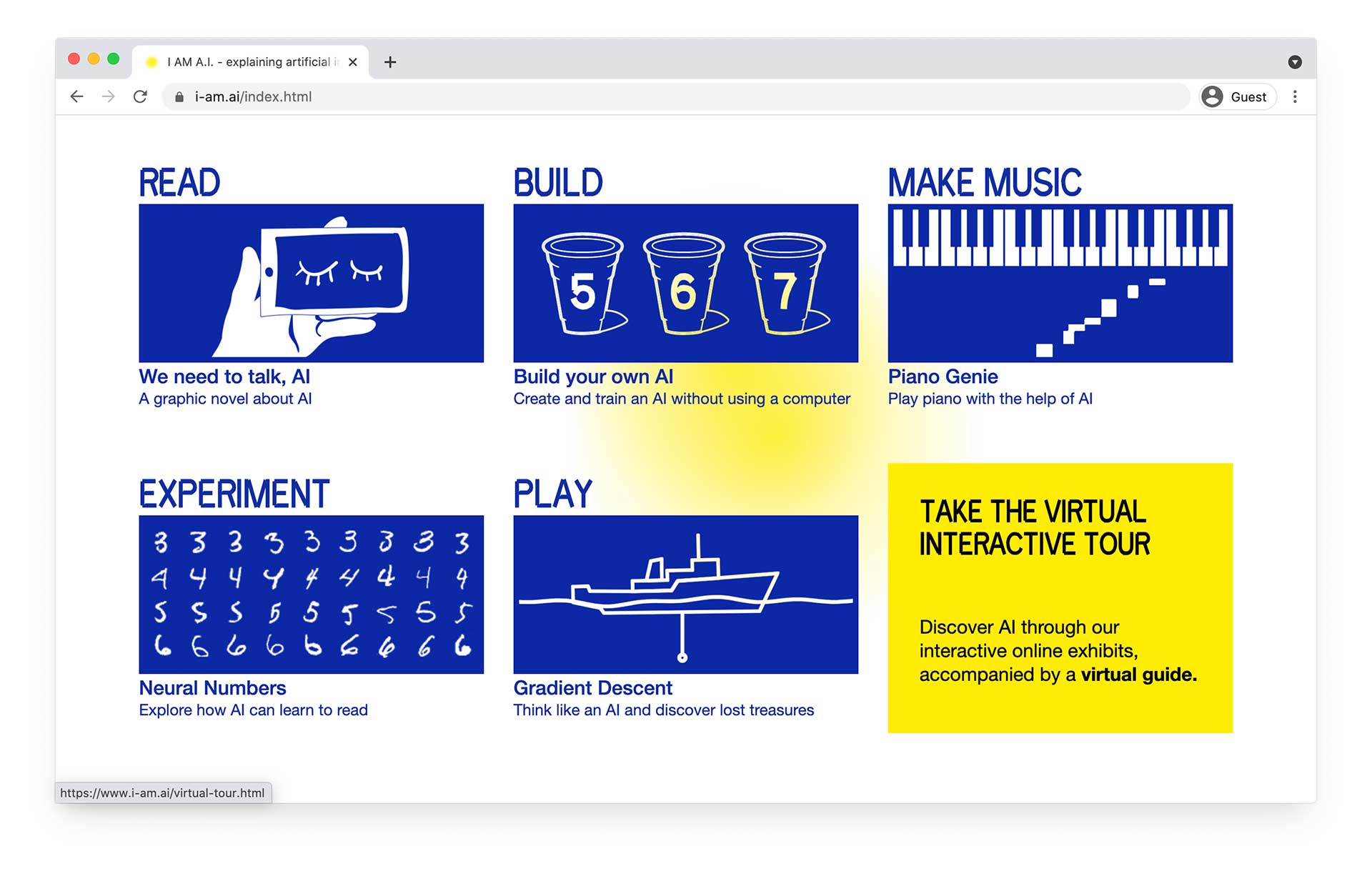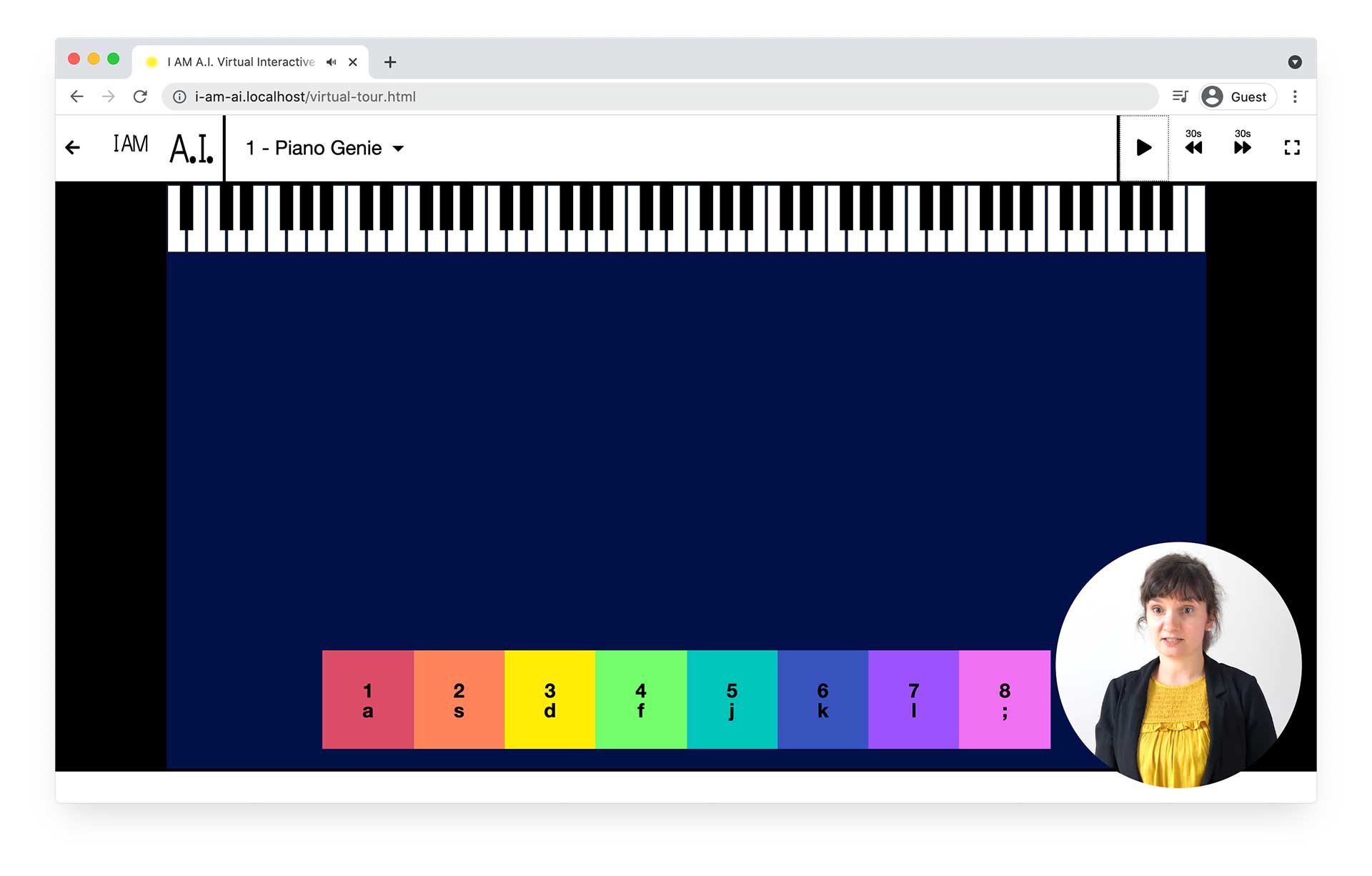Reimagining I AM A.I. as an online exhibition
When the COVID-19 pandemic broke in early 2020, we had to postpone the opening of our brand new exhibition, I AM A.I. - explaining artificial intelligence. It features 14 exhibits, most of them computer-based interactives. Very quickly, we decided to create an internet-based online exhibition to present at least part of our work and connect with our audience.
We started by surveying existing online museum exhibitions. What we found, in most cases, were 3D reproductions of the museum space, navigable using Google’s Street View and similar software. These didn’t fit our goals for several reasons:
- We were showcasing the content of our traveling exhibition, not a museum space.
- Our exhibition is based on interactive software instead of images or objects.
- In typical navigable 3D spaces, it’s hard to present dense information (text, complex images). Also, the UI is dedicated to moving and looking around, leaving few possibilities for interaction.
We knew that many key aspects of a museum visit would be lost in translation: the happiness of a day out with friends or family, the unique construction of the exhibits, the direct contact with guides and facilitators. We accepted our digital experience would be fundamentally different. However, we wanted to preserve some of the rich engagement with the contents. We also wanted a “visit” to be an out-of-the-ordinary event.
We asked ourselves: How can we make a visit different from a regular web browsing session? How can we create an atypical experience within a familiar setting? How can our exhibition materialize beyond the screen? How can we transform or intervene the visitor’s home?
The human body has the power to resignify spaces and create new perspectives through physical actions. This is something many of us realized during the pandemic: exercising in front of the TV, singing happy birthday to someone through a computer screen, or participating in an international conference from our kitchen. Physical actions can change our mindset and make everyday spaces fresh. We searched for our answers there.
We designed five virtual exhibits by looking for different ways to engage the visitor, their body, and the space around them. Each exhibit corresponds to a physical action (reading, making music, playing a game, investigating, crafting). We considered the body’s disposition when interacting with each exhibit, how it moved in space, the rhythm of movement, and the different levels of engagement (intellectual, physical, creative, emotional).
Our virtual exhibits are:
- an interactive AI piano that invites you to role-play a virtuoso and make music through the computer keyboard or a tablet touch screen;
- a comic book delivered as a PDF e-book, which you can read sitting back comfortably;
- a video game that requires fast thinking, and two people can play using gamepads;
- an AI that recognizes handwriting that you can experiment with and explore its training process under the hood; and
- a DIY activity where you build an A.I. on your kitchen table using cups, sticks, pen, and paper without using any digital devices.

Other physical modes we thought of and will explore in the future:
- a treasure hunt, searching your home for things you didn’t even know were there;
- taking photos based on prompts to see things from new viewpoints;
- participating in a collective creation with other people; and
- DIY board and role-playing games.
In building a rich virtual experience it’s important to think of what happens on both sides of the screen, and to consider engagement in terms of movement and space, not only intellectually and emotionally.
During the pandemic, gourmet restaurants found many creative and inspiring ways for producing unique and extraordinary experiences in their customers’ dining tables:
- shipping individually packed ingredients with instructions to assemble beautiful looking gourmet dishes;
- video conference sessions where a chef guides a small group of people in making a dish;
- QR codes to access specially curated music playlists to play during dinner;
- red light bulbs delivered with the food to match the restaurant’s lighting at home.
Guiding virtually
Our interactive exhibits for museums are full-screen applications, which offer very focused experiences. They are accompanied by external texts, guides, and put in context through the exhibition’s spatial design. For the virtual exhibition, we embedded our software within texts, taking inspiration from Explorable Explanations. This is a novel format in which interactives are presented within prose to guide visitors and allow them to jump back and forth between reading explanations and trying out things.
These texts guide visitors in their exploration, illuminate the more complex concepts, and pose open questions. Internally we called each of these interactive episodes “trails” to reinforce the idea of storytelling through movement, and laying out a narrative through space.
We also wanted to include a guided tour in our virtual exhibition to cater to visitors who feel more comfortable with a guide presenting the content. The simplest solution was using a video conference software, like Zoom, but we had some concerns:
- It can be hard to guarantee visitors’ commitment to showing up in a video conference session at a certain reserved date and time and staying for the whole tour.
- Some visitors might require assistance setting up their software and hardware, which might hold up the whole group.
- Guiding a tour of interactive software requires people opening a separate window and switching back and forth with the video conference.
Our solution was to create a new experimental format: The Virtual Interactive Tour. It integrates our interactive exhibits with a pre-recorded video of our tour guide that appears in a small bubble in the corner of the screen. The video has scripted triggers at various points that start, stop or modify the exhibits, add extra elements, overlay visual explanations, etc. At some points, the guide invites the visitor to test something out at their own pace and waits until they signal that they’re done. The software also allows for non-linear scripts, jumping to different points depending on the visitor’s actions or choices.

With school groups, guided tours using video conference software have fewer issues. We can count on the group’s presence and permanence, and students are already familiar with the software and hardware. We use traditional video conference software in this case, and provide live tours with an actual guide. Inviting students to interact with our exhibit during the tour is still the most challenging part. We have tested various alternatives, like sharing a web page with links for each activity, or e-learning software that allows the guide to open web pages on the student’s web browser.
Even though our self-guided trails, our Virtual Interactive Tour, and our school workshops are based on the same exhibits, the text or guide script for each is different. Visitor’s capacity for absorbing information is not the same when reading, listening to a pre-recorded explanation, or participating in a video conference. Written text can be re-read as much as needed allowing for a more in-depth discussion of the content; a live guide on the other hand can adapt to the group’s level or interests and answer questions.
Beyond the pandemic
We don’t consider our virtual exhibition a replacement for the physical one. During development, we referred to it as the “digital companion”. Once the physical exhibition opens (soon, hopefully) we’ll offer this online complement to school groups who want to prepare for their visit in the classroom, and visitors who wish to continue and deepen their explorations at home at a different pace.
Developing an online exhibition revolutionized the way we think about our content and about the ways that people can engage with it. It has also helped us in our mission of reaching a global audience, and made the opening of a new exhibition a worldwide event. We’re sure that we’ll continue exploring these possibilities, our new tools, and ways of connecting with the public in the future. We expect new exhibitions to have their “digital companion” planned from the start.

